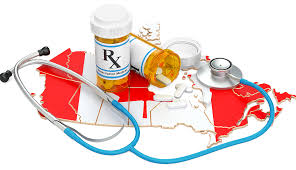
(UNDATED) – Representative Trey Hollingsworth is wanting Hoosier’s opinion the Department of Health and Human Services (HHS) and the Food and Drug Administration (FDA) recently announced a Safe Importation Action Plan to allow Americans to import certain drugs from Canada.

Under President Trump’s leadership, the Department of Health and Human Services (HHS) and the Food and Drug Administration (FDA) are releasing this Safe Importation Action Plan to describe steps HHS and FDA will take to allow the safe importation of certain drugs originally intended for foreign markets. The Action Plan describes two pathways to provide safe, lower-cost drugs to consumers.
Under Pathway 1, a Notice of Proposed Rulemaking (“NPRM”) would rely on the authority in the Federal Food, Drug, and Cosmetic Act (“FD&C Act”) section 804 to authorize demonstration projects to allow the importation of drugs from Canada.
The NPRM would include conditions to ensure the importation poses no additional risk to the public’s health and safety and that it will achieve significant cost savings to the American consumer.
Under Pathway 2, manufacturers could import versions of FDA-approved drug products that they sell in foreign countries that are the same as the U.S. versions. Under this pathway, manufacturers would use a new National Drug Code (NDC) for those products, potentially allowing them to offer a lower price than what their current distribution contracts require.
Some elements of the final proposal may differ from the descriptions below to reflect further consideration of the relevant issues.
Pathway 1: Under this pathway, States, wholesalers, or pharmacists could submit plans for demonstration projects for HHS to review outlining how they would import Health-Canada approved drugs that are in compliance with section 505 of the FD&C Act.
The importation would occur in a manner that adequately assures the drug is what it purports to be and that meets the cost requirements of the rulemaking.
The demonstration projects would be time-limited and require regular reporting to ensure safety and cost conditions are being met. The NPRM would address the following:
- Past Consideration of Section 804: The NPRM would address past consideration of importation under section 804 and discuss what has changed since those previous reviews.
- Implements Section 804(b)-(h): The NPRM would implement section 804(b)-(h), which allows for the importation of drugs from Canada by pharmacists and wholesalers if certain conditions are met regarding drug quality, record keeping, testing, and protection against counterfeiting. The NPRM would list those requirements and invite proposals as to how those conditions would be met by a demonstration project.
- Conditional Certification: Section 804(l) requires a certification to Congress that implementation of section 804 will pose no additional risk to the public’s health and safety and will result in a significant reduction in the cost of covered products to the 2 American consumer. The NPRM would propose to condition certification on the ability to limit the program to demonstration projects under section 804(b)-(h) and would seek comments on that proposal.
- Demonstration Projects: The NPRM would propose that States, wholesalers, or pharmacists submit applications to HHS demonstrating how they will comply with the statutory safety and cost conditions as well as additional requirements that would be imposed to approve a demonstration. The demonstrations would be time-limited and require reporting and renewal and could be revoked if conditions are not met. Applications from States would need to propose an arrangement with a wholesaler or pharmacist that meets the conditions of the NPRM.
- Eligible Drugs: The NPRM would propose that drugs eligible for importation must be drugs authorized for sale in Canada that are versions of FDA-approved prescription drugs. Specifically, such drugs would be eligible for importation if they contain only active pharmaceutical ingredients (API) manufactured at facilities that also manufacture API for the FDA-approved version, and if they are formulated using processes, specifications, and facilities that are used in accordance with the approved new drug application for the FDA-approved version. The NPRM would require attestation and supporting documentation regarding the authenticity and eligibility of a drug.
- Non-Eligible Drugs: The NPRM would restate the exclusions listed in section 804(a)(3); namely, controlled substances, biological products, infused drugs, intravenously injected drugs, drugs inhaled during surgery, and certain parenteral drugs would be excluded from this pathway. The NPRM would additionally exclude any drug with a REMS.
- Additional Safety Requirements: HHS may not have access to data that would verify that a drug imported under this pathway is the same as the FDA-approved drug. The NPRM will help address this issue by requiring applicants to demonstrate how they will comply with:
- track and trace requirements to allow drug tracing from manufacture to pharmacy;
- certain labeling requirements to ensure the imported drugs meet all labeling requirements of the FD&C Act;
- requirements to ensure foreign sellers engaged in the distribution of the imported drugs are registered;
- importation entry requirements (e.g., providing certain electronic information demonstrating that each shipment should be allowed into the U.S.); and
- post-importation requirements such as adverse event reporting, procedures to facilitate recalls, and CGMP for certain manufacturing activities such as relabeling.
- Cost Requirements: The NPRM would explain the requirement for demonstrating that drugs imported under this pathway must result in a significant reduction in the cost of covered drug products to the American consumer. As such, the NPRM would seek 3 feedback on the best way to identify the expected acquisition cost of the imported drug, the cost of assuring the drug is safely imported, and the mechanism for delivering those savings to the consumer (as opposed to the savings being absorbed by the supply chain).
- Transparency: The NPRM would require some indication in the labeling that drugs imported under this program were originally intended for distribution in Canada. In particular, the NPRM would seek comment on requiring that the label include the NDC, part of which would be unique to drugs imported under this program.
- Compliance: The NPRM would explain that in addition to FDA’s typical compliance tools (e.g., import alerts, warning letters, etc.), the Secretary would have broad discretion to terminate a demonstration project if the continuation could pose additional risk to public health and safety.
- Severability: The rulemaking would be clear that if any provision of Pathway 1 in a final rule is invalidated by a court, the entirety of Pathway 1 should be invalidated because the certification would be based on the ability to implement section 804 with the conditions imposed in the rulemaking.
Pathway 2: Manufacturers of FDA-approved drug products would be able to import versions of these FDA-approved drugs that they sell in foreign countries into the U.S. To use this pathway, the manufacturer or person authorized by the manufacturer would need to establish with FDA that the foreign version is the same as the U.S. version (such as through manufacturing records).
If this condition is met, FDA would allow the drug to be labeled for sale in the U.S. (potentially with labeling that identifies the product as originally manufactured for sale abroad) and imported pursuant to section 801(d) of the FD&C Act under the existing approval for the U.S. approved version.
The Administration has reason to believe that manufacturers might use this pathway as an opportunity to offer Americans lower-cost versions of their own drugs.
In recent years, multiple manufacturers have stated (either publicly or in statements to the Administration) that they wanted to offer lower-cost versions but could not readily do so because they were locked into contracts with other parties in the supply chain.
This pathway would highlight an opportunity for manufacturers to use importation to offer lower-cost versions of their drugs. A manufacturer that met the requirements for this pathway could sell a foreign version of a drug product in the U.S. under a different NDC number than the U.S. version, which could allow the manufacturer to introduce the product at a lower price.
Because the manufacturer would be able to cause its drug to be imported through conventional supply channels, this pathway generally would rely on applicable existing safeguards to ensure supply chain integrity.
HHS is considering whether any additional safeguards would be necessary to establish that the drug being imported is in fact, for example, the European version of an FDA-approved drug that the manufacturer has caused to be labeled to be marketed in the U.S.
HHS may seek comments on whether manufacturers would seek to lower costs under this pathway, what additional elements might be important to include, and whether this pathway could more effectively be implemented by using authority under section 804.
If costs can be lowered significantly through this pathway, there may be reduced need for the demonstration projects outlined in Pathway 1.
Representative Trey Hollingsworth wants Hoosiers opinion on this plan.
Question of the Week: As our country continues to address high drug prices, which approach do you believe would best solve this issue?
[_] Safe importation of foreign drugs.
[_] Unrestricted foreign drug importation.
[_] Cap out-of-pocket costs for Medicare Part D drug program participants.
[_] Require drug manufacturer rebates to be given directly to the customers instead of to pharmacy benefit managers (PBMs).
[_] Reform drug patent laws to allow generics to come to market sooner.
[_] I don’t know.
[_] Other (share your thoughts).



